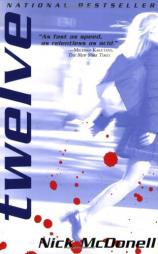Reading Group Guide
Discussion Questions
Twelve

1. The book opens with a description of White Mike: "White Mike is thin and pale like smoke" (p. 3). White Mike is a drug dealer who doesn't use drugs. How does this set up the book?
2. This novel is set on the Upper East Side of New York City. Do you think that the setting is inherent to the story? Could the events in this novel be translated to other parts of the country? Los Angeles? Atlanta? Kansas City?
3. One of the main themes of this book is the impact of drugs on youth culture. Is that message an anti-drug one? Or does the book, in a sense, glorify the youth drug culture and those who participate in it?
4. How does the youth culture described in Twelve differ from the youth culture that Jim Carroll described in The Basketball Diaries? Or that Bret Easton Ellis brought to life in Less Than Zero?
5. The novel offers a unique look at race relations among teenagers. This is most graphically depicted in the scene at the Rec (p. 8). How does the interaction between black and white kids differ from your preconceptions? Or is what happens between the two groups what you have been led to expect?
6. The socioeconomic variables among the different teens at the school are not played up. All the characters assume that everyone else is upper middle class to upper class with extremely wealthy parents—just like themselves. Is this a commentary on how money affects even the children? What is McDonell saying about those effects?
7. White Mike remembers that he was once told he was in an "existential crisis" and that he should read Albert Camus's The Plague (p. 92). How does the existential philosophy affect White Mike's decisions later in the story? Or does he reject this judgment?
8. What do the actions Jessica goes through to procure the drug twelve say about the dehumanizing affects of drugs on youth (pp. 107, 224)?
9. If they felt that their parents would listen, what do you think these kids would tell them?
10. How is this generation alike and different from those that preceded it? Think here about the sixties. Are these the same issues, or are these more exacerbated?
11. Was it possible for this story to have ended another way? Or was the violent path written right from the beginning?
12. It is possible to arrest this kind of behavior in future generations? What needs to be done to make this happen?
13. Is there anything enviable about White Mike and his world? Reading this, do you feel you would want to live in his world?
14. The climax of the story—with White Mike confronting Lionel, Lionel pulling Charlie's gun, and Claude pulling the trigger of the Uzi—all comes in the short span of two pages (pp. 237-239). Why do you think McDonell punches such an emotional whallop into such a short space?
15. Has White Mike changed over the course of the story? Is he a different character from when he appeared "thin and pale like smoke" to when he decides "it was okay" to smoke in Paris (p. 244)? What changes can you perceive in him?
SUGGESTED FURTHER READING
Catcher in the Rye by J. D. Salinger; City of Night by John Rechy; Pure by Rebbecca Ray; Bongwater by Michael Hornburg; Black Snow by Liu Heng; Jack Frusciante Has Left the Band by Enrico Brizzi; By the Shore by Galaxy Craze; Downers Grove by Michael Hornburg; Fat Bald Jeff by Leslie Stella; Naked Lunch by William S. Burroughs; Prague by Arthur Phillips; Less Than Zero by Bret Easton Ellis; The Lovely Bones by Alice Sebold; The Rules of Attraction by Bret Easton Ellis; Jesus' Son by Denis Johnson; Scar Vegas and Other Stories by Tom Paine; Sarah by J. T. Leroy; Try by Dennis Cooper; Brave New Girl by Louisa Luna; The Fuck-Up by Arthur Nersesian; The Perks of Being a Wallflower by Stephen Chbosky
Twelve
- Publication Date: August 9, 2012
- Genres: Fiction
- Paperback: 244 pages
- Publisher: Grove Press
- ISBN-10: 0802140122
- ISBN-13: 9780802140128







